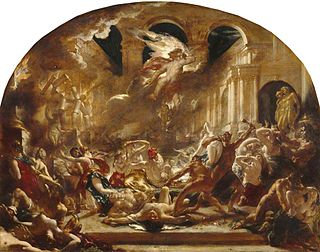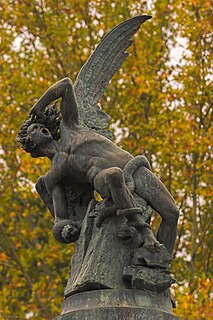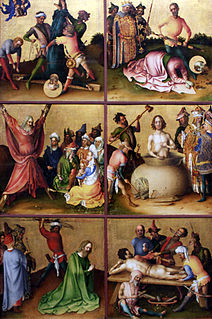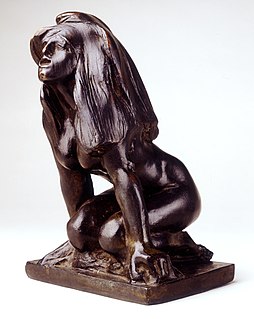 W
WThe Crucifixion of Saint Wilgefortis is a c. 1497 triptych by the Early Netherlandish painter Hieronymus Bosch. The subject of the painting has been uncertain, and it has also been known as the Triptych of the Crucified Martyr, or The Crucifixion of Saint Julia, but is now believed to depict Saint Wilgefortis.
 W
WThe Destroying Angel and Daemons of Evil Interrupting the Orgies of the Vicious and Intemperate, also known as The Destroying Angel and Daemons Inflicting Divine Vengeance on the Wicked and Intemperate and as The Destruction of the Temple of Vice, is an oil painting on canvas by English artist William Etty, first exhibited in 1832. Etty had become famous for nude paintings, and acquired a reputation for tastelessness, indecency and a lack of creativity. With The Destroying Angel he hoped to disprove his critics with an openly moral piece. The painting is 127.8 cm by 101.9 cm and depicts a classical temple under attack from a destroying angel and a group of daemons. Some of the humans appear dead or unconscious, others flee or struggle against the daemons.
 W
WThe Four Witches, or The Four Naked Women, or The Four Sorceresses or Scene in a Brothel) are titles given to a 1497 engraving by the German Renaissance artist Albrecht Dürer. One of his earliest signed engravings, it shows four nude, exuberant women gathered conspiratorially in a circle in a confined interior setting, perhaps a bath house, which appears to have entrances from either side. Although clearly erotic, a small horned demon, perhaps representing temptation, is positioned in the left hand portal, peering out and holding what may be a hunting object, and is engulfed in flames.
 W
WThe Fuente del Ángel Caído is a fountain located in the Buen Retiro Park in Madrid, Spain.
 W
WThe Garden of Earthly Delights is the modern title given to a triptych oil painting on oak panel painted by the Early Netherlandish master Hieronymus Bosch, between 1490 and 1510, when Bosch was between 40 and 60 years old. It has been housed in the Museo del Prado in Madrid, Spain since 1939.
 W
WGood and Evil is a painting by Victor Orsel, begun in Rome in 1829 and completed in Paris in 1832 after several preparatory works.
 W
WHell is a Hieronymus Bosch painting made after 1490. It is currently in the Palazzo Ducale, in Venice, Italy.
 W
WKnight, Death and the Devil is a large 1513 engraving by the German artist Albrecht Dürer, one of the three Meisterstiche completed during a period when he almost ceased to work in paint or woodcuts to focus on engravings. The image is infused with complex iconography and symbolism, the precise meaning of which has been argued over for centuries.
 W
WLast Judgement is a c. 1435 tempera on oak polyptych by the German artist Stefan Lochner, probably commissioned for the council chamber of City Hall of Cologne, but now broken apart. Today the outer wings, which formed a sixfold partition when extended, have been sawed off into twelve individual pictures, most of which are still extant but held in separate collections, mostly in Cologne, Munich and Frankfurt. The interior wings included the Martyrdom of the Apostles, the exterior panels comprised in part of the Saint Anthony Abbot, Mary Magdalene and a Donor, Saints Catherine, Hubert, Quirinus of Neuss, and a Donor, and Pope Cornelius. Its depiction of the Last Judgment follows many of the conventions of contemporary doom paintings, but Lochner introduces important innovations, especially in his rendering of the angel's black and flowing clothes.
 W
WThe Last Judgment is a triptych attributed to Flemish painter Hans Memling and painted between 1467 and 1471. It is now in the National Museum in Gdańsk in Poland. It was commissioned by Angelo Tani, an agent of the Medici at Bruges, but was captured at sea by Paul Beneke, a privateer from Danzig. A lengthy lawsuit against the Hanseatic League demanded its return to Italy. It was placed in the Basilica of the Assumption but in the 20th century it was moved to its present location.
 W
WThe Nightmare is a 1781 oil painting by Anglo-Swiss artist Henry Fuseli. It shows a woman in deep sleep with her arms thrown below her, and with a demonic and apelike incubus crouched on her chest.
 W
WThe Seven Deadly Sins and the Four Last Things is a painting attributed to Hieronymus Bosch or to a follower of his, completed around 1500 or later. Since 1898 its authenticity has been questioned several times. In 2015 the Bosch Research Conservation Project claimed it to be by a follower, but scholars at the Prado, where the painting hangs, dismissed this argument. The painting is oil on wooden panels and is presented in a series of circular images.
 W
WThe Succubus is a bronze sculpture with a green and dark brown patina. It was originally conceived in 1889 by the French artist Auguste Rodin as part of a set of works showing sirens and Nereids. It later formed part of his state-commissioned monument to Victor Hugo. It is now in the Museo Soumaya in Mexico City.
 W
WThe Temptation of Saint Anthony is a 1945 painting by the German artist Max Ernst. It depicts the desert father Anthony the Great as he is tormented by demons in Egypt.
 W
WThe Temptation of St. Anthony is an engraving, probably created c. 1470-75, by Martin Schongauer of this popular scene in 15th-century art. In it grotesque demons swarm around Saint Anthony the Great, bursting with movement and energy as the saint calmly resists their temptations or blows. St. Anthony is shown with some of his signature attributes, dressed in a monk's religious habit and cowl, carrying a staff with a tau-shaped handle and his bound girdle book hanging from his belt. The literary source from which this image derives is debated. The image could depict chapter 65 from Athanasius's Life of St. Anthony, where the hermit has a vision of himself floating through the air and undefined beings prevent him from ascending back to reality or it could show the ninth chapter of Athanasius's Life of St. Anthony, where St. Anthony is attacked by the devil in the form of animals and beasts in the Egyptian desert and is levitated in the air by his practice of rigorous asceticism.
 W
WTobias and Sarah in Prayer with the Angel Raphael and the Demon is an oil on canvas painting by the Dutch Golden Age painter Jan Steen. It is now in the collection of the Bredius Museum, The Hague.
 W
WThe Torment of Saint Anthony is the earliest known painting by Michelangelo, painted as a close copy of the famous engraving by Martin Schongauer when he was only 12 or 13 years old. It is now in the Kimbell Art Museum in Fort Worth, Texas. It shows the common medieval subject, included in the Golden Legend and other sources, of Saint Anthony being assailed in the desert by demons, whose temptations he resisted; the Temptation of St Anthony is the more common name of the subject. But this composition apparently shows a later episode where St Anthony, normally flown about the desert supported by angels, was ambushed in mid-air by devils.
 W
WThe Triptych of Temptation of St. Anthony is an oil painting on wood panels by the Early Netherlandish painter Hieronymus Bosch, dating from around 1501. The work tells the story of the mental and spiritual torments endured by Saint Anthony the Great, one of the most prominent of the Desert Fathers of Egypt in the late 3rd and early 4th centuries. The Temptation of St. Anthony was a popular subject in Medieval and Renaissance art. In common with many of Bosch's works, the triptych contains much fantastic imagery. The painting hangs in the Museu Nacional de Arte Antiga in Lisbon.
 W
WUntitled is a painting created by American artist Jean-Michel Basquiat in 1982. The artwork was sold at Christie's for $57.3 million in May 2016. At the time, that was the record for Basquiat's most expensive painting. It is currently Basquiat's third highest auction record, and fourth most expensive painting.